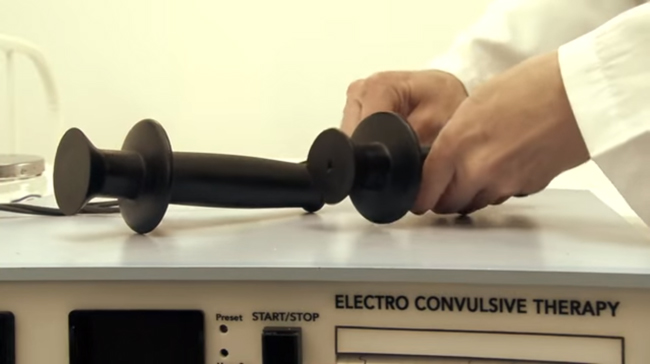LOS ANGELES, CALIFORNIA
HUMAN RIGHTS GROUP CALLS FOR ACTION TO STOP WIDESPREAD USE OF BRAIN-DAMAGING ELECTROSHOCK TREATMENT
March 11, 2016
The Citizens Commission on Human Rights (CCHR) has launched a public service announcement (PSA) warning about the documented risks of electroshock treatment. The PSA calls for survivors of the treatment, their families, healthcare professionals and others to urgently oppose the Food and Drug Administration’s (FDA) plan to reclassify the electroconvulsive therapy (ECT) device as low risk. CCHR was established in 1969 by the Church of Scientology and eminent psychiatrist, Prof. Thomas Szasz. It has been responsible for dozens of laws in the U.S. and around the world either implementing informed consent or a prohibition of ECT for some age groups.

“[G]iven the volume of evidence demonstrating its substantive brain-damaging outcomes, we call for an immediate global ban on the use of electroshock on all children. — Cheryl van Daalen-Smith, Assoc. Professor, York University, et al., 2014 study on ECT”
CCHR charges that device makers should fulfill a mandate that the FDA gave them in 1979 to provide clinical evidence of safety and efficacy.[1] To date, this has not been done.
Despite this and while acknowledging “significant risks associated with ECT,” the FDA plans to reduce the risk classification given to the device in 1976 and has given a deadline of March 28, 2016 for people to comment on its proposal.[2] CCHR urges people to report any knowledge of ECT damage by logging onto the FDA site.
You can make a public comment to the Food and Drug Administration (FDA) here:ECT is administered to 100,000 U.S. citizens each year.[3] Yet, the FDA lists fourteen health risks associated with ECT, including:
- “Death may result from various complications of ECT such as reactions to anesthesia, cardiovascular complications, pulmonary complications, or stroke.”
- “Cardiovascular complications. The…convulsions may be accompanied by arrhythmias (irregular heartbeat) or ischemia/infarction (i.e., heart attack). Hypertension (high blood pressure) as well as hypotension (low blood pressure) may be associated with ECT treatment.”
- “Cognition and memory impairment. ECT treatment may result in memory impairment, specifically immediate post-treatment disorientation, anterograde memory impairment [loss of the ability to create new memories] and retrograde personal memory impairment [loss of memory-access to events that occurred, or information that was learned, before an injury].”[2]
According to an announcement of the pending rule change from the FDA, the agency is proposing changing the classification of ECT devices “for use in treating severe major depressive episode (MDE) associated with major depressive disorder (MDD) or bipolar disorder (BPD) in patients 18 years of age and older who are treatment-resistant or who require a rapid response due to the severity of their psychiatric or medical condition.”[2]
CCHR says that because the FDA does not regulate medical practice, if it reclassifies the device, it could potentially open the door to widespread use of electroshock, including on children. It is already being studied for use on autistic children.[4]
Jan Eastgate, President of CCHR International says: “Because the FDA does not regulate medical practice, classifying the ECT device as Class II for any ‘disorders’ opens the door to a massive potential for off label use and possible enforced treatment of involuntarily detained patients and children.”
A 2014 study by Cheryl van Daalen-Smith, et al. stated: “The ongoing and growing interest within psychiatry in prescribing electroshock or shock-like procedures for treating certain behaviors or conditions deemed psychoneurologic in children is of grave concern, given that the plethora of evidence that electroshock has at its very core an intent to damage and incapacitate the brain appears to be ignored.” The authors concluded that “given the volume of evidence demonstrating its substantive brain-damaging outcomes, we call for an immediate global ban on the use of electroshock on all children.”[4]
A February 16, 2013, United Nations Special Rapporteur on Torture and Other Cruel Inhuman or Degrading Treatment or Punishment report defined procedures such as electroshock without the consent of the patient as a form of torture.[5]
Eastgate says, “Anyone concerned about patient protections and safeguarding lives should immediately oppose the FDA’s harmful proposal.”
References:
[1] Federal Register, Vol. 44, No. 172, September 4, 1979, pages 51776-51777, reporting 21 Code of Federal Regulations Part 882, [Docket No. 78N-1103], ia600307.us.archive.org/3/items/federalregister44tunit/federalregister44tunit.pdf (page 490 of PDF).
[2] Leslie Kux, Associate Commissioner for Policy, “Neurological Devices; Reclassification of Electroconvulsive Therapy Devices Intended for Use in Treating Severe Major Depressive Episode in Patients 18 Years of Age and Older Who Are Treatment Resistant or Require a Rapid Response; Effective Date of Requirement for Premarket Approval for Electroconvulsive Therapy for Certain Specified Intended Uses,” December 18, 2015, 21 Code of Federal Regulations Part 882, Federal Register Number 2015-32592, regulations.gov/#!documentDetail;D=FDA-2014-N-1210-0001
[3] “Electroconvulsive Therapy (ECT).” Mental Health America, mentalhealthamerica.net/ect
[4] Cheryl van Daalen-Smith, et al., “The Utmost Discretion: How Presumed Prudence Leaves Children Susceptible to Electroshock,” CHILDREN and SOCIETY, Vol. 28, 205-217 (2014), chrysm-associates.co.uk/images/vanDaalen-Smith&Breggin2014_ECTchildren.pdf
[5] A/HRC/22/53, “Report of the Special Rapporteur on torture and other cruel, inhuman or degrading treatment or punishment, Juan E. Méndez,” United Nations, General Assembly, Human Rights Council, Twenty-second Session, Agenda Item 3, 1 Feb. 2013, p. 21, para 85, http://www.ohchr.org/Documents/HRBodies/HRCouncil/RegularSession/Session22/A.HRC.22.53_English.pdf.
